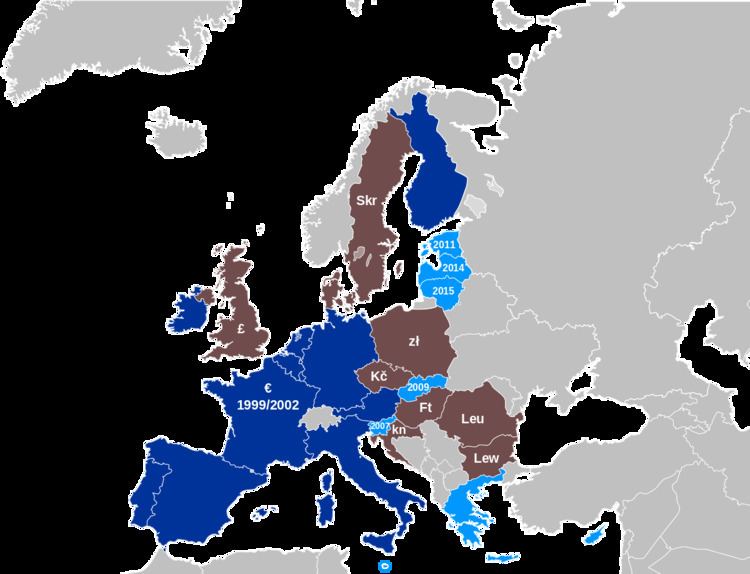 | ||
There are eleven currencies of the European Union as of 2015, the principal currency being the Euro. The Euro is used by the institutions of the European Union and by the Eurozone states, which account for 19 of the 28 member states of the European Union. All but two states are obliged to adopt the currency; Denmark and the United Kingdom, through a legal opt-out from the EU treaties, have retained the right to operate independent currencies within the European Union. The remaining eight states must join the ERM II and attain the third stage and adopt the Euro eventually.
Contents
Euro
The euro is the result of the European Union's project for economic and monetary union which came fully into being on 1 January 2002. and it is now the currency used by the majority of European Union's member states, with all but three bound to adopt it. It is the currency used by the institutions of the European Union and in the failed European Constitution it was to be included with the symbols of Europe as the formal currency of the European Union. The euro is also widely used by other states outside the EU.
Current currencies
Note that there are other currencies used in overseas territories of member states. Those territories however are not part of the European Union proper (legally subject to all its law) so are not listed here.Exchange rate regimes of EU countries according to Reinhart and Rogoff
Reinhart and Rogoff classifies the exchange rate regimes of EU countries as follows:
The classification codes are:
Northern Cyprus
EU law and treaties application to Northern Cyprus is currently suspended. Its territory is claimed by the Republic of Cyprus, one of the EU member states, but currently Northern Cyprus is under Turkish Republic of Northern Cyprus (TRNC) control. TRNC isn't recognised by the Republic of Cyprus (which claims jurisdiction over the whole island) and the European Union.
EU law would start to apply in Northern Cyprus if it comes under control of the Republic of Cyprus (if the Cyprus dispute is resolved through unification), whose official legal tender is the Euro.
Presently, the TRNC government has declared the Turkish lira (TL, TRY) to be its legal tender. TL is not issued by any EU member state, but by Turkey and it has a free floating regime. Nevertheless, usage of the Euro in Northern Cyprus is already high in practice.
Opt-outs
During the negotiations of the Maastricht Treaty of 1992 the United Kingdom secured an opt-out, while a protocol gave Denmark the right to decide if and when they would join the euro. Denmark subsequently notified the Council of the European Communities of their decision to opt out of the euro, and this was included as part of the 1992 Edinburgh Agreement, a Decision of Council, reached following the Maastricht Treaty's initial rejection in a 1992 Danish referendum. The purpose of the agreement was to assist in its approval in a second referendum, which it did.
Sweden, which is obliged to adopt the treaty under the terms of its accession treaty, held a referendum in 2003 on adopting the euro which was rejected by the Swedish electorate. The government has chosen to deliberately fail to meet the convergence criteria for euro adoption by not joining ERM II without prior approval by a referendum. The European Commission stated it would respect this decision for now but not tolerate similar moves from countries that join the EU after the euro is introduced.
Institutions
Those European Union states that have adopted it are known as the eurozone and share the European Central Bank (ECB). The ECB and the national central banks of all EU countries, including those who operate an independent currency, are part of the European System of Central Banks. Before a state adopts the euro, its currency has to spend at least two years in the European Exchange Rate Mechanism which pegs it to the euro within a fixed band. Currently two currencies are in ERM, including the Danish Krone which has an opt-out. The Bulgaria lev is also pegged via a currency board.
Future
Except for the two states with opt outs, all current and future members of the EU are obliged to adopt the Euro as their currency, thus replacing their current ones. Denmark, which has an opt out, is planning to hold a referendum on its opt-outs due to increasing pressure to adopt the euro. The Danish Kroner is already pegged to the euro, and Denmark has fulfilled all the requirements for adoption.
